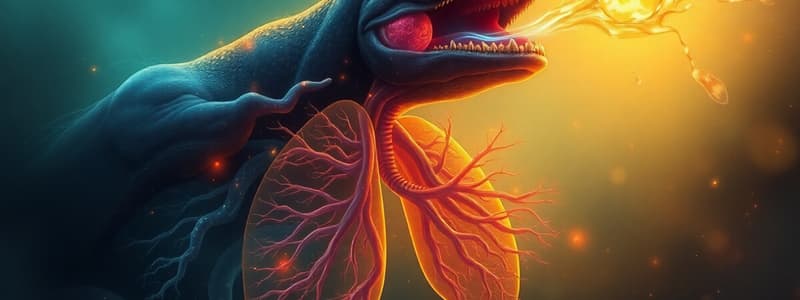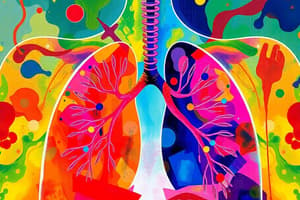Podcast
Questions and Answers
What is the main function of the respiratory system?
What is the main function of the respiratory system?
- To deliver oxygen to cells and remove carbon dioxide (correct)
- To maintain stable body temperature
- To pump blood throughout the body
- To support digestion
Larger, warm-blooded animals rely on simple diffusion to extract enough oxygen for bodily function.
Larger, warm-blooded animals rely on simple diffusion to extract enough oxygen for bodily function.
False (B)
What muscle controls human breathing?
What muscle controls human breathing?
diaphragm
Fish extract oxygen from water through their _____
Fish extract oxygen from water through their _____
Which of the following statements is true regarding red blood cells?
Which of the following statements is true regarding red blood cells?
Match the following animal systems to their primary functions:
Match the following animal systems to their primary functions:
The lungs of a human have a surface area of approximately _____ square meters.
The lungs of a human have a surface area of approximately _____ square meters.
Veins carry oxygenated blood away from the heart.
Veins carry oxygenated blood away from the heart.
What characteristic is primarily associated with ectotherms?
What characteristic is primarily associated with ectotherms?
Endotherms have slower metabolisms than ectotherms.
Endotherms have slower metabolisms than ectotherms.
What type of heart do reptiles and amphibians have?
What type of heart do reptiles and amphibians have?
The _____ system provides the energy needed for muscle contraction and organ function.
The _____ system provides the energy needed for muscle contraction and organ function.
Match the following groups of animals with their heart types:
Match the following groups of animals with their heart types:
Which of the following organisms can absorb oxygen through their skin?
Which of the following organisms can absorb oxygen through their skin?
The diaphragm contracts during exhalation to increase pressure in the lungs.
The diaphragm contracts during exhalation to increase pressure in the lungs.
What is the role of the circulatory system?
What is the role of the circulatory system?
The _____ collects blood from the lower body and delivers it to the heart.
The _____ collects blood from the lower body and delivers it to the heart.
What happens during inhalation?
What happens during inhalation?
Match the heart chambers with their functions:
Match the heart chambers with their functions:
All animals from reptiles onward have lungs located in front of the heart.
All animals from reptiles onward have lungs located in front of the heart.
Fish obtain oxygen from water through their _____?
Fish obtain oxygen from water through their _____?
Flashcards
Capillaries
Capillaries
Very small blood vessels that allow for the exchange of oxygen and carbon dioxide between the blood and body cells. They have thinner walls than arteries and contain valves to prevent backflow.
Heart's Role
Heart's Role
The organ responsible for pumping blood throughout the body, delivering oxygen and removing carbon dioxide. Crucial for maintaining body temperature and providing energy.
Endotherms (Warm-Blooded)
Endotherms (Warm-Blooded)
Animals that maintain a stable internal body temperature, requiring a constant supply of energy and oxygen. They can regulate their own temperature regardless of the environment.
Ectotherms (Cold-Blooded)
Ectotherms (Cold-Blooded)
Signup and view all the flashcards
Digestive System
Digestive System
Signup and view all the flashcards
Respiration
Respiration
Signup and view all the flashcards
Simple Diffusion
Simple Diffusion
Signup and view all the flashcards
Larger Size
Larger Size
Signup and view all the flashcards
Warm-Blooded
Warm-Blooded
Signup and view all the flashcards
Gills
Gills
Signup and view all the flashcards
Lungs
Lungs
Signup and view all the flashcards
Diaphragm
Diaphragm
Signup and view all the flashcards
Circulatory System
Circulatory System
Signup and view all the flashcards
What are ectotherms?
What are ectotherms?
Signup and view all the flashcards
What are endotherms?
What are endotherms?
Signup and view all the flashcards
What type of heart do fish have?
What type of heart do fish have?
Signup and view all the flashcards
What type of heart do reptiles and amphibians have?
What type of heart do reptiles and amphibians have?
Signup and view all the flashcards
What powers the respiratory and circulatory systems?
What powers the respiratory and circulatory systems?
Signup and view all the flashcards
Aorta
Aorta
Signup and view all the flashcards
Inhalation
Inhalation
Signup and view all the flashcards
Exhalation
Exhalation
Signup and view all the flashcards
Heart
Heart
Signup and view all the flashcards
Blood
Blood
Signup and view all the flashcards
Study Notes
Respiration
- Animals require oxygen to produce energy and release carbon dioxide as a byproduct.
- Respiratory and circulatory systems collaborate to deliver oxygen to cells and remove carbon dioxide.
- Respiration involves lungs for gas exchange, but some animals use simple diffusion across moist membranes.
- Simple diffusion facilitates oxygen absorption through skin, particularly in amphibians.
- Large size and warm-bloodedness hinder simple diffusion, making it inefficient for larger, warm-blooded animals like mammals and birds.
- Larger animals demand more oxygen due to increased bodily functions.
- Warm-bloodedness (endothermy) requires constant energy and thus more oxygen to maintain stable body temperature.
- Moist membranes are essential for gas exchange via diffusion.
- Fish utilize gills to extract oxygen from dissolved water.
- Lungfish exemplify an evolutionary step towards lung-based respiration. Lungfish possess lungs, which is of note in the context of animal kingdom evolution.
- Reptiles and higher animals possess lungs situated behind the heart, maximizing gas exchange efficiency.
- Lungs provide a vast surface area for oxygen absorption via moist membranes (e.g., human lungs boast 75 square meters of surface area, exceeding a typical house roof).
- Human breathing relies on the diaphragm, a large, flat muscle below the lungs. Diaphragm contraction expands the lungs, decreasing pressure and drawing air in. Relaxation causes lung contraction, releasing air and increasing pressure.
- The circulatory system acts as a pump, delivering oxygen throughout the body and removing carbon dioxide.
- The heart, the circulatory system's central component, pumps blood throughout the body.
- Blood circulation follows a figure-eight pattern, originating at the heart, delivering oxygenated blood, returning deoxygenated blood to the lungs for oxygenation, before returning to the heart.
- Red blood cells transport oxygen and carbon dioxide within the circulatory system.
- The heart's four chambers ensure efficient blood flow, especially the large left ventricle, which generates high pressure for oxygenated blood distribution.
- Arteries, with thick, muscular walls, carry oxygenated blood away from the heart and maintain high pressure.
- Veins, with thinner walls and valves, return deoxygenated blood towards the heart to prevent backflow.
- Capillaries, tiny blood vessels, facilitate oxygen and carbon dioxide exchange between blood and body cells.
- The heart is vital for circulatory system function, driving oxygen delivery and carbon dioxide removal, ensuring stable body temperature and energy production.
- Warm-blooded animals (endotherms) have a constant demand for energy and oxygen to maintain internal temperature.
- Cold-blooded animals (ectotherms) rely on their environment for temperature regulation and therefore exhibit slower metabolisms, requiring less oxygen.
- Circulatory system complexity reflects evolutionary progress, particularly in the increased number of heart chambers among higher animals.
- Arthropods have small pores on their bodies for oxygen intake.
- Fish possess a two-chambered heart (one ventricle and one atrium), oxygenating blood through gills and then pumping to the body.
- Reptiles and amphibians have a three-chambered heart (two atria and one ventricle), where some blood mixing occurs before oxygenation.
- All animals from reptiles onwards have lungs located behind the heart.
- Lungs are composed of oxygen-absorbing membranes kept moist by mucus.
- Simple diffusion is the mechanism for oxygen transfer in the lungs.
- Inhalation brings oxygen into the body through the nose and mouth; exhalation expels carbon dioxide.
- The diaphragm, a large, flat muscle beneath the lungs, controls breathing.
- Inhalation involves diaphragm contraction, increasing lung volume; exhalation involves relaxation, decreasing lung volume.
- Pressure changes within the lungs drive air flow.
- The left ventricle pumps oxygenated blood into the aorta.
- The aorta distributes blood to the body through smaller arteries.
- Capillaries facilitate oxygen exchange with cells. Deoxygenated blood returns through veins.
- The vena cava (superior and inferior) returns blood to the heart's right atrium.
- Blood then flows to the right ventricle and into the pulmonary artery to the lungs.
- In the lungs, blood becomes oxygenated and travels through the pulmonary veins. Oxygenated blood enters the left atrium and then the powerful left ventricle.
- The digestive system provides energy for muscle contraction and organ function.
Evolutionary Development in Respiration
- Lungfish represent an early step in lung evolution.
Studying That Suits You
Use AI to generate personalized quizzes and flashcards to suit your learning preferences.




